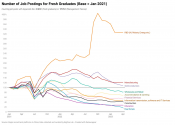I think the main problem here is that the metric for youth unemployment as defined in China is just not really meaningful
There is a credible argument here that
@Eventine made (see below) that there is an increasing skills mismatch in the labour force between demand/supply of workers. This, while not a sign of economic weakness, is still a problem that needs to be dealt with.
China youth unemployment would peak on July and go down until Dec. Expect two more months of nonstop coverage from the West and liberals in China talking about doom and gloom of China.
I am more interested in how much youth unemployment would go down between August and December. It would be an indicator of the strengthen of the Chinese economy and if a further and stronger stimulus is needed to jump start the recovery or not.
We'll see, I hope you're right.
My understanding is that this is mostly migrant workers becoming unemployed due to slow downs in low skill manufacturing (which is increasingly automated; and also subject to global demand declines and higher average wages in China) and services (due to the lock downs bankrupting many small and medium service businesses).
The former can't really be fixed. Manufacturing workers have to skill up because the economy is changing and it's not possible for China to employ that many assembly workers anymore - low skill manufacturing industries are just disappearing or shifting to lower wage countries.
The latter can be fixed. And here is where the government can be blamed for not acting more quickly to restore service jobs and support small and medium businesses after the lock downs ended.
Careful there, the latter point you raise would invite the extremists here with:
<facetious> how dare you blame the government!? it's all a plan </facetious>
Automation is definitely happening, but that largely applies to manufacturing workforce which is ~100mln or so according to an NBS Survey. That workforce will shrink over time as workforce ages. However, it is definitely true that there is a skills mismatch and that is the problem I've alluded to. The problem here, is that the pressure to employ more university graduates will grow as tertiary enrollment has grown substantially. The point that
@FairAndUnbiased does not seem to understand is that having a lot of STEM graduates and university graduates is great *only* if there are sufficient jobs for them that maximizes their skills (and therefore wages). Having 50mln highly educated and under/unemployed STEM university grads working as delivery drivers/DIDI drivers is how you have the precursor of social unrest.

I'm just going to leave this data here for you to read.

